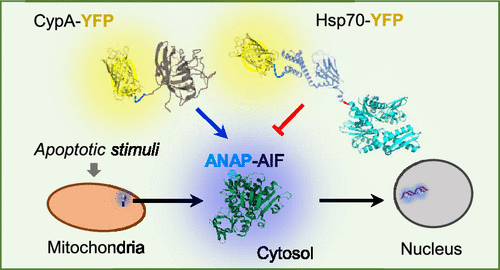当前位置:
X-MOL 学术
›
ACS Chem. Biol.
›
论文详情
Our official English website, www.x-mol.net, welcomes your feedback! (Note: you will need to create a separate account there.)
Real-Time Spatial and Temporal Analysis of the Translocation of the Apoptosis-Inducing Factor in Cells
ACS Chemical Biology ( IF 4 ) Pub Date : 2021-10-25 , DOI: 10.1021/acschembio.1c00565 Sang-Hyun Park 1 , Sanggil Kim 2 , Hyun Soo Lee 2 , Injae Shin 1
ACS Chemical Biology ( IF 4 ) Pub Date : 2021-10-25 , DOI: 10.1021/acschembio.1c00565 Sang-Hyun Park 1 , Sanggil Kim 2 , Hyun Soo Lee 2 , Injae Shin 1
Affiliation

|
Translocation of the apoptosis-inducing factor (AIF) from the mitochondria to the nucleus is crucial for AIF-mediated apoptosis. However, the lack of methods for real-time spatial and temporal analysis of translocation of functional AIF is a large hurdle to gain a detailed understanding of this process. In this study, a genetic code expansion technique was developed to overcome this hurdle. Specifically, this technique was utilized to construct ANAP-AIF containing a small fluorescent amino acid (ANAP) at a specific site in cells. Additionally, we developed efficient fluorescence resonance energy-transfer systems consisting of ANAP-AIF and either yellow fluorescent protein (YFP)-fused cyclophilin A (CypA) or Hsp70, respective positive and negative regulators for AIF translocation to the nucleus. We found that apoptosis inducers, including apoptozole, 2-phenylethynesulfonamide (PES), myricetin, Bam7, reactivating p53 and inducing tumor apoptosis (RITA), brefeldin A, and carbonyl cyanide-p-trifluoromethoxyphenylhydrazone (FCCP) promote translocation of mitochondrial AIF to the cytosol after 4 h incubation, reaching a maximum after 6–7 h. However, these substances did not enhance AIF translocation to the nucleus through the interaction of AIF with Hsp70 in the cytosol. On the other hand, treatment with apoptosis inducers, such as paclitaxel, silibinin, doxorubicin, actinomycin D, and camptothecin caused AIF translocation to the nucleus after 4 h incubation through AIF binding to CypA, reaching saturation after 6–7 h. It was also found that Hsp70 and CypA regulate AIF translocation in a mutually exclusive manner because they do not interact with AIF simultaneously in cells undergoing apoptosis. The results demonstrate clearly that ANAP-incorporated proteins are powerful to obtain a more in-depth understanding of protein translocation.
中文翻译:

细胞凋亡诱导因子易位的实时时空分析
细胞凋亡诱导因子 (AIF) 从线粒体转移到细胞核对于 AIF 介导的细胞凋亡至关重要。然而,缺乏对功能性 AIF 易位进行实时时空分析的方法是详细了解这一过程的一大障碍。在这项研究中,开发了一种遗传密码扩展技术来克服这一障碍。具体而言,该技术用于在细胞的特定位点构建含有小荧光氨基酸 (ANAP) 的 ANAP-AIF。此外,我们开发了由 ANAP-AIF 和黄色荧光蛋白 (YFP) 融合的亲环蛋白 A (CypA) 或 Hsp70 组成的高效荧光共振能量转移系统,它们分别是 AIF 易位至细胞核的正负调节剂。我们发现细胞凋亡诱导剂,p-三氟甲氧基苯腙 (FCCP) 在孵育 4 小时后促进线粒体 AIF 易位至胞质溶胶,在 6-7 小时后达到最大值。然而,这些物质并没有通过 AIF 与胞质溶胶中 Hsp70 的相互作用增强 AIF 向细胞核的易位。另一方面,用凋亡诱导剂处理,如紫杉醇、水飞蓟宾、阿霉素、放线菌素 D 和喜树碱,在孵育 4 小时后通过 AIF 与 CypA 结合导致 AIF 易位至细胞核,在 6-7 小时后达到饱和。还发现 Hsp70 和 CypA 以相互排斥的方式调节 AIF 易位,因为它们在经历细胞凋亡的细胞中不会同时与 AIF 相互作用。结果清楚地表明,结合 ANAP 的蛋白质对于更深入地了解蛋白质易位具有强大的作用。
更新日期:2021-11-19
中文翻译:

细胞凋亡诱导因子易位的实时时空分析
细胞凋亡诱导因子 (AIF) 从线粒体转移到细胞核对于 AIF 介导的细胞凋亡至关重要。然而,缺乏对功能性 AIF 易位进行实时时空分析的方法是详细了解这一过程的一大障碍。在这项研究中,开发了一种遗传密码扩展技术来克服这一障碍。具体而言,该技术用于在细胞的特定位点构建含有小荧光氨基酸 (ANAP) 的 ANAP-AIF。此外,我们开发了由 ANAP-AIF 和黄色荧光蛋白 (YFP) 融合的亲环蛋白 A (CypA) 或 Hsp70 组成的高效荧光共振能量转移系统,它们分别是 AIF 易位至细胞核的正负调节剂。我们发现细胞凋亡诱导剂,p-三氟甲氧基苯腙 (FCCP) 在孵育 4 小时后促进线粒体 AIF 易位至胞质溶胶,在 6-7 小时后达到最大值。然而,这些物质并没有通过 AIF 与胞质溶胶中 Hsp70 的相互作用增强 AIF 向细胞核的易位。另一方面,用凋亡诱导剂处理,如紫杉醇、水飞蓟宾、阿霉素、放线菌素 D 和喜树碱,在孵育 4 小时后通过 AIF 与 CypA 结合导致 AIF 易位至细胞核,在 6-7 小时后达到饱和。还发现 Hsp70 和 CypA 以相互排斥的方式调节 AIF 易位,因为它们在经历细胞凋亡的细胞中不会同时与 AIF 相互作用。结果清楚地表明,结合 ANAP 的蛋白质对于更深入地了解蛋白质易位具有强大的作用。



























 京公网安备 11010802027423号
京公网安备 11010802027423号